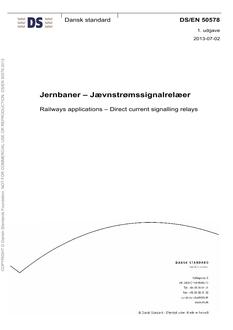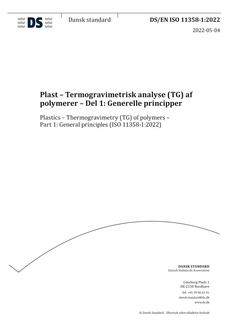-
-
Available Formats
- Availability
- Priced From ( in USD )
-
Available Formats
-
- Immediate download
- $75.00
- Add to Cart
-
- Printed Edition
- Ships in 1-2 business days
- $75.00
- Add to Cart
Customers Who Bought This Also Bought
-

DANSK DS/EN 50578
Priced From $51.00 -

DANSK DS/EN 15163-1
Priced From $101.00 -

DANSK DS/EN ISO 11358-1
Priced From $60.00 -

DANSK DS/EN ISO 9073-6
Priced From $60.00
About This Item
Full Description
This European Standard specifies the test method for cables designed to have intrinsic resistance to fire and intended for use as emergency circuits for alarm, lighting and communication purposes. This European Standard is applicable to cables for emergency circuits of rated voltage not exceeding 600 V/1 000 V, including those of rated voltage below 80 V and optical fibre cables. This European Standard includes details for the specific point of failure, continuity checking arrangement, test sample, test procedure and test report relevant to electric power and control cables with rated voltage up to and including 600 V/1 000 V. Details for the specific point of failure, continuity checking arrangement, test sample, test procedure and test report relevant to copper data and telecom cables and optical cables are given in the relevant standards of CLC/TC 46X and CLC/TC 86A. The test method is limited to cables with an overall diameter not exceeding 20 mm. The test method is based on the direct impingement of flame from a propane burner giving a constant temperature attack of a notional 842 °C. It is intended to be used for cables for emergency circuits suitable for alarm, emergency lighting and communication. NOTE When the test method is used in support of EN 13501-3, it only applies to cables of less than 20 mm diameter, and, for metallic conductor cables, to those with conductor sizes up to and including 2,5 mm². For optical cables, only the less than 20 mm diameter limit applies. This European Standard includes (Annex B) the field of direct application and rules for extended application of test results (EXAP). Details regarding classification using data from this test are given in EN 13501-3 . Information regarding classification is given in Annex D. This European Standard also includes informative guidance (Annex E) on a means of applying a water spray to the cable during the test. Such a requirement may be a feature of particular product standards.





